Mercury’s 48-volt alternator and Fathom e-Power, state-of-the-art boat power?
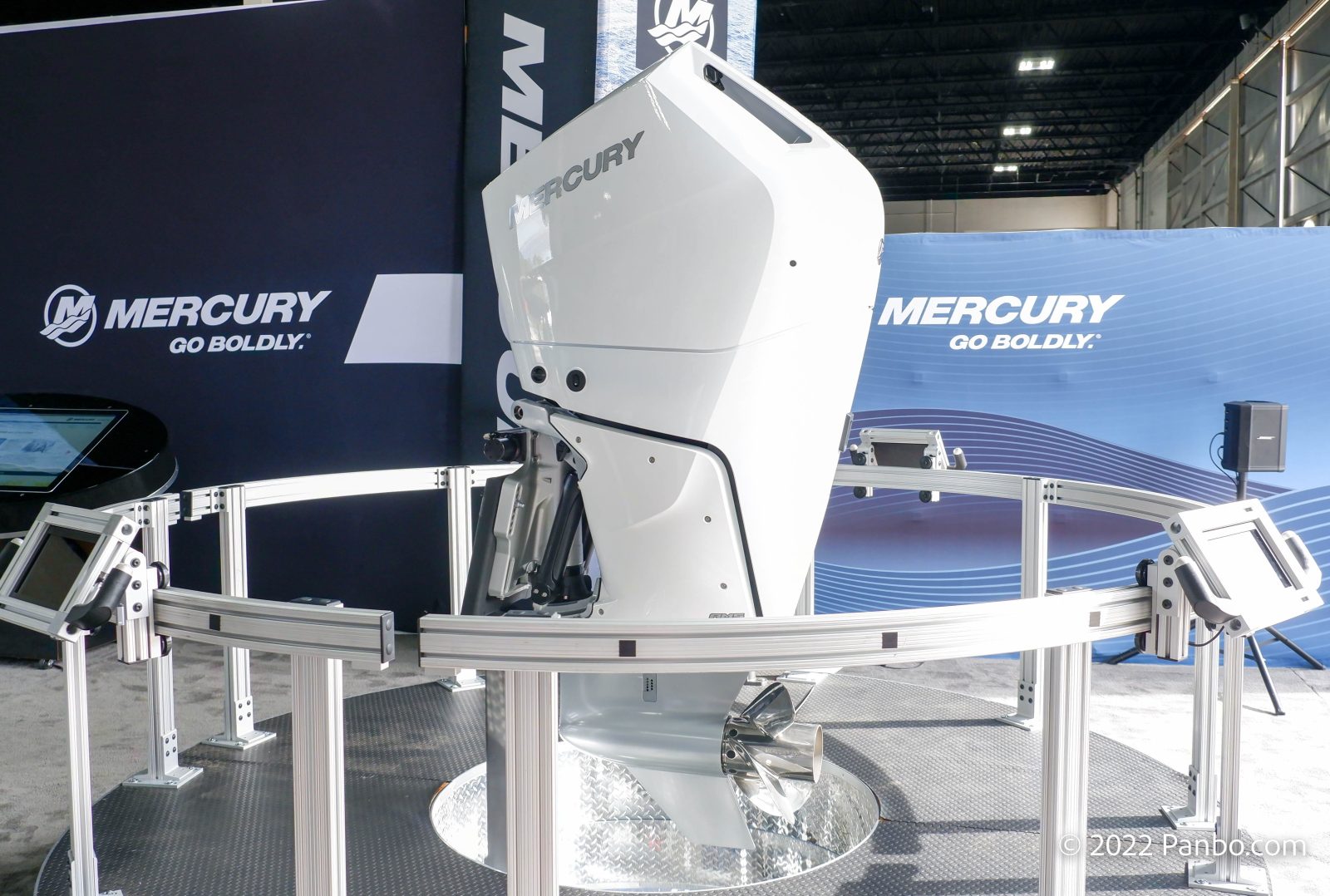
An engine launch event might be an odd fit for an electronics and technology blog. I’ve attended Mercury launch events before, and each time, there’s been plenty of technology news. But when I went, I wasn’t expecting an announcement that could change the industry. I certainly didn’t anticipate the thunder from the launch of a 350 or 400-horsepower, 10-cylinder engine would be stolen by an alternator.
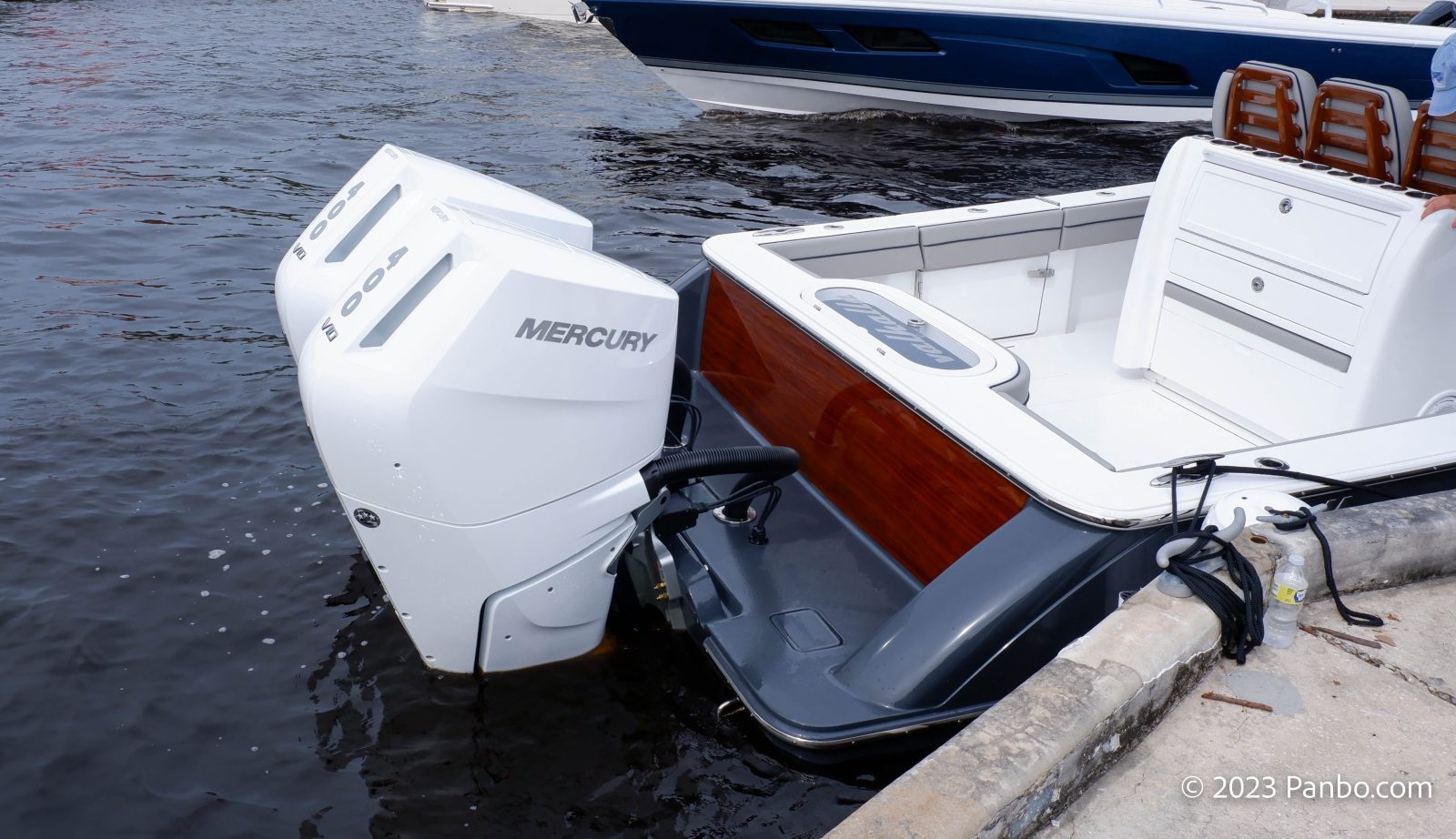
Before we talk too much about the alternator, let’s take a minute to talk about the engine to which that alternator comes attached. The all-new 350 or 400-horsepower V10 Verado comes on the heels of Mercury’s 600-horsepower V12. While the V10 doesn’t deliver as much groundbreaking technology as the two-speed gearbox and steerable lower unit of the V12, it does deliver just as much refinement. Like the 600hp engine, as long as the exhaust isn’t in sport mode, it’s hard to believe the engine is even running. It’s shockingly smooth and refined.
The 350 and 400 horsepower versions of the 5.7 liter V10 Verado engine weigh 695 pounds. Mercury says the engine is 45 percent quieter than its 425 horsepower competitor. I think it’s safe to assume that the competitor is the 425-horsepower Yamaha XTO. It’s worth mentioning that the lightest version of the XTO comes in at 952 pounds. Additionally, the Verado runs on 87-octane fuel, while the Yamaha requires 89-octane. Most ethanol-free gasoline we buy on the water is 90 octane, so that difference might not show up in your wallet.
Fathom e-Power

Brunswick’s Fathom e-Power system comprises all of the components needed to deliver seamless AC and DC power aboard their boats. A large, LiFePO4 battery bank, one or more inverters, digital switching, and a robust control system enable that seamless experience. The 48-volt alternator works with and is offered exclusively as part of a Fathom e-Power system. That means you won’t be able to order an engine with the 48-volt alternator and take advantage of it with an existing DC system. Additionally, Fathom is only available on new builds, so if you want to take advantage of all this goodness, it will need to be on a new boat.
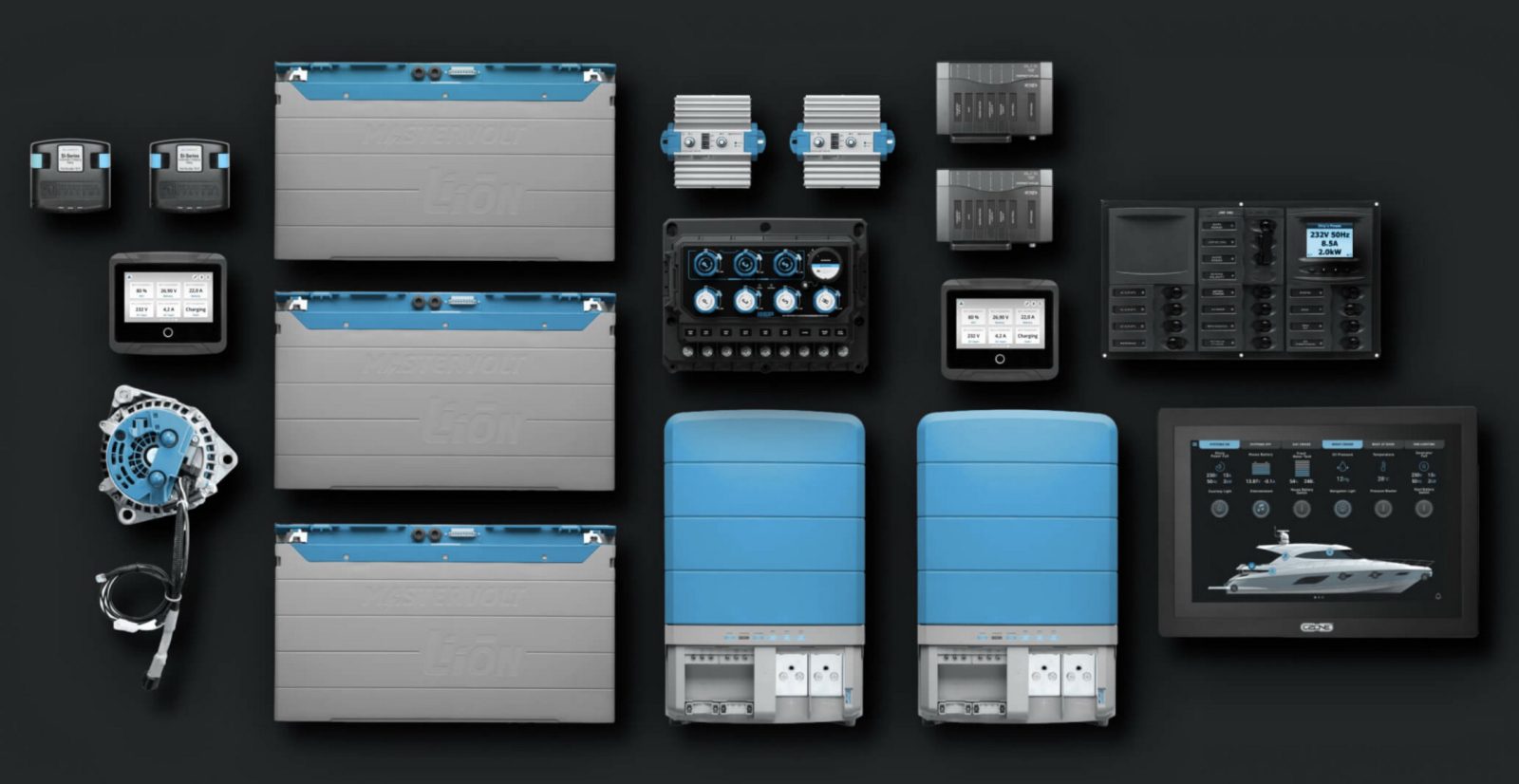
Brunswick’s portfolio of brands allows them to deliver all the pieces needed. Mastervolt’s MLi batteries and Combis Inverters make up the primary energy storage and power conversion, Mercury engines provide power via their alternators, CZone provides digital switching and system management, and Blue Sea and BEP provide power distribution, gauges, relays, and more.
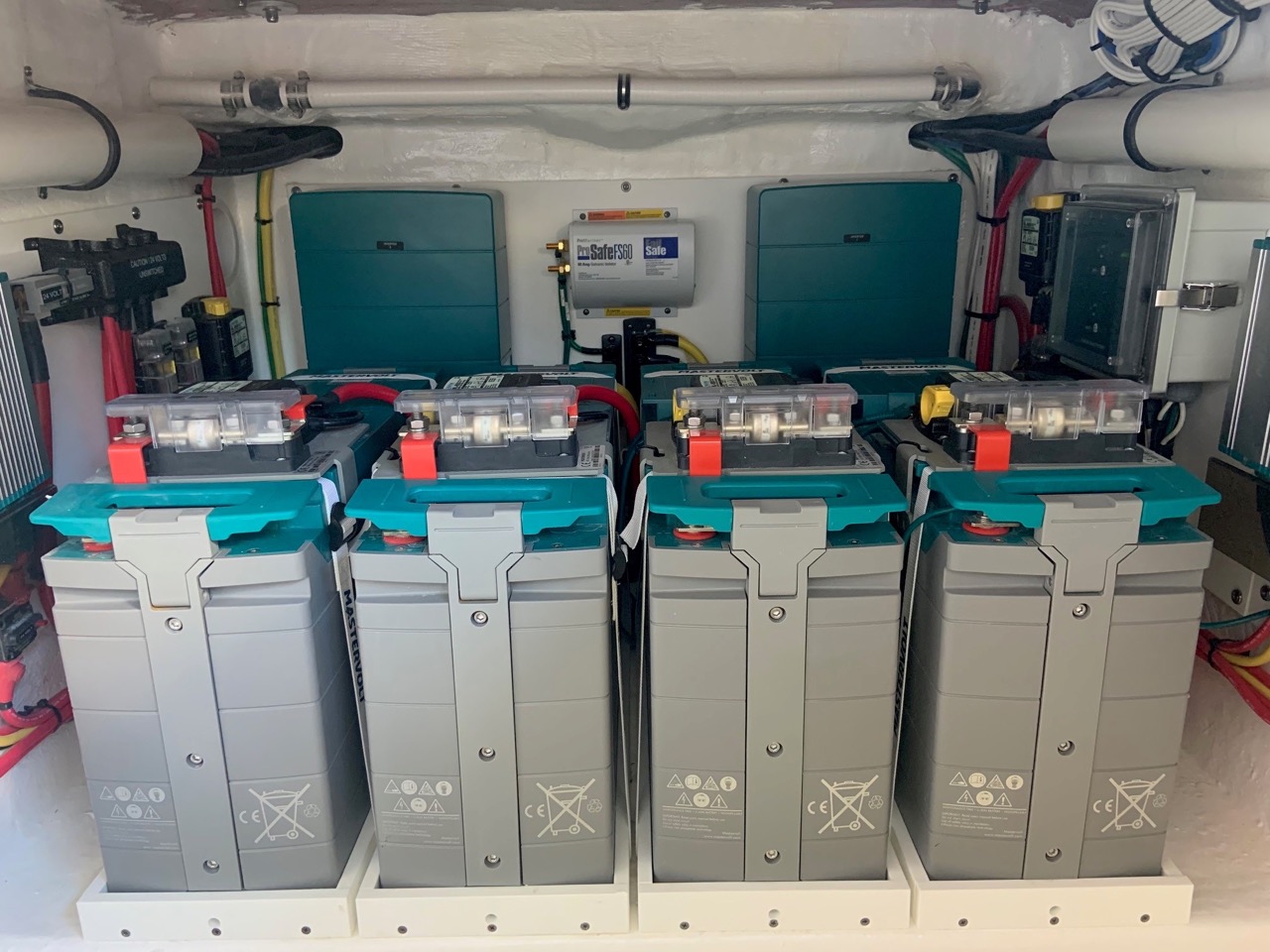
The name and most of the system actually aren’t new. I was on the 2020 Miami Innovation Awards jury that awarded Sea Ray’s SLX-R 400e an innovation award in large part for the power system that delivered the comforts of a generator-equipped boat without a generator. But, while the SLX-R’s system could only deliver that comfort until loads depleted the batteries. Then it was time to head back to the dock and shore power to recharge the system. The missing ingredient was a way to quickly charge the batteries on the water without resorting to a separate generator.
48-volt alternator to the rescue
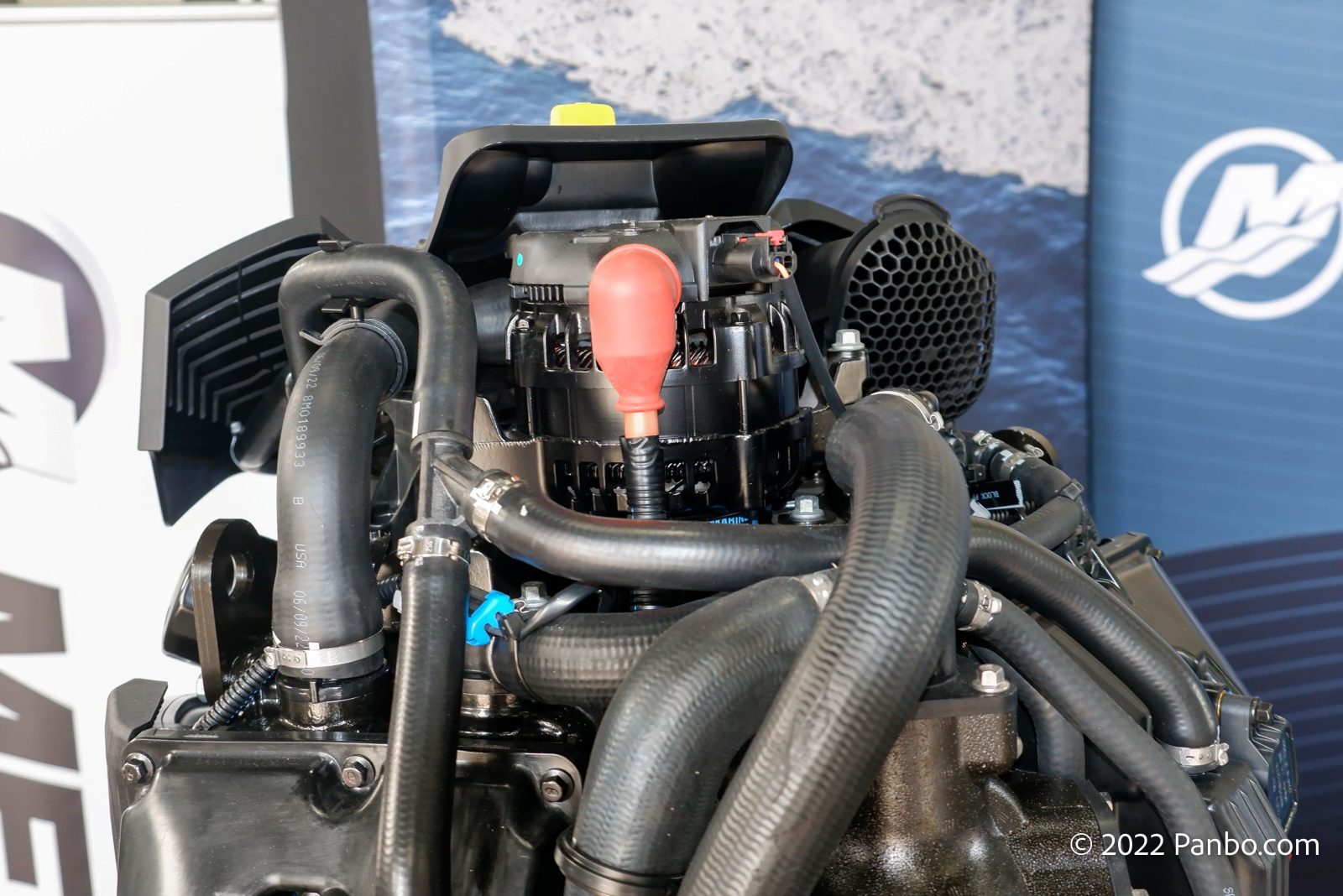
As I mentioned, previous Fathom e-Power systems have been able to deliver comfort on the water. But, only until the exhausting the batteries’ capacity. Even the mighty 600-horsepower V12 only has a 150-amp, 12-volt alternator. But, a maximum of 100 amps is available to the boat, with the rest powering the engine and steering system. That means about 1,200 watts per motor is available for other loads. So, on a triple-engine boat, a maximum of 3,600 watts would be available for house loads and charging the batteries. Simply put, 3,600 watts isn’t likely to keep up with house 120-volt and 12-volt loads, let alone recharge the batteries. And that power is only available when the boat is moving.
That’s where the 48-volt alternator on the Verado V10 comes in and potentially completes the system. The 48-volt alternator is a dual-voltage alternator. By connecting or disconnecting additional coils, the alternator switches between producing 12-volt and 48-volt DC power. In 48-volt mode, the alternator can produce up to 7,200 watts of power at cruising RPMs. A twin-engine boat can produce up to 14,400 watts of power, a triple-engine boat 21,600 watts, and a quad-engine boat a whopping 28,800 watts.
Power+ mode
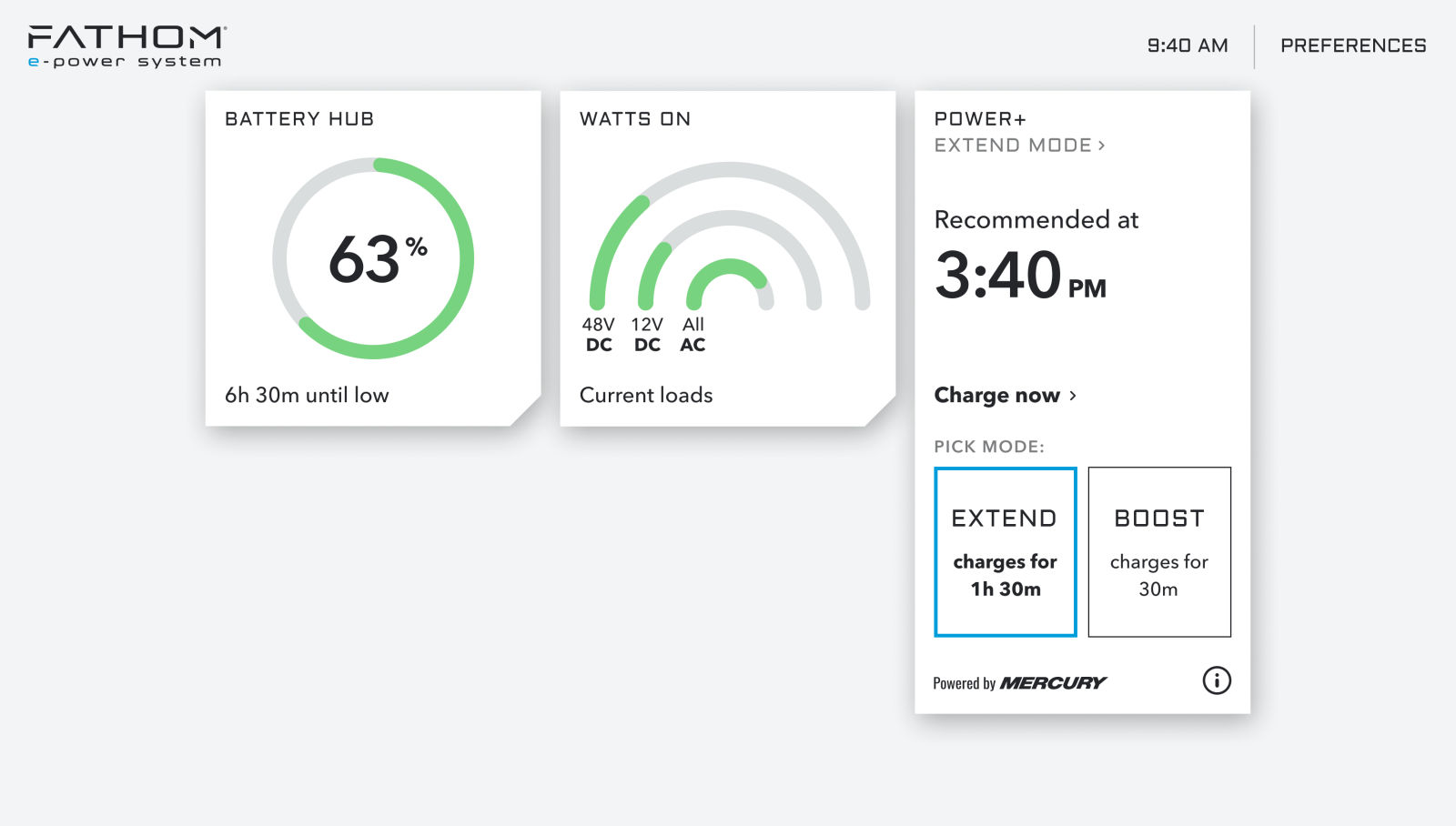
All the discussion of available power above was when the engines were running to move the boat. But, the 48-volt equipped V10s come with a new trick. That trick has a name, Power+, a generator mode in which the engine runs with a different fuel mixture for a leaner, more efficient burn. In Power+ mode, the alternator can produce up to 5 kilowatts of power, depending on whether Extend (lower RPMs and quieter) or Boost (higher RPMs and a little louder) is selected.
48-volt alternator-equipped engines track two separate hours counts. One for hours with the engine running in its normal mode and a second for Power+ time. Although I haven’t been able to quantify it, Mercury says Power+ runtime has a minimal impact on engine longevity.
Putting it all together
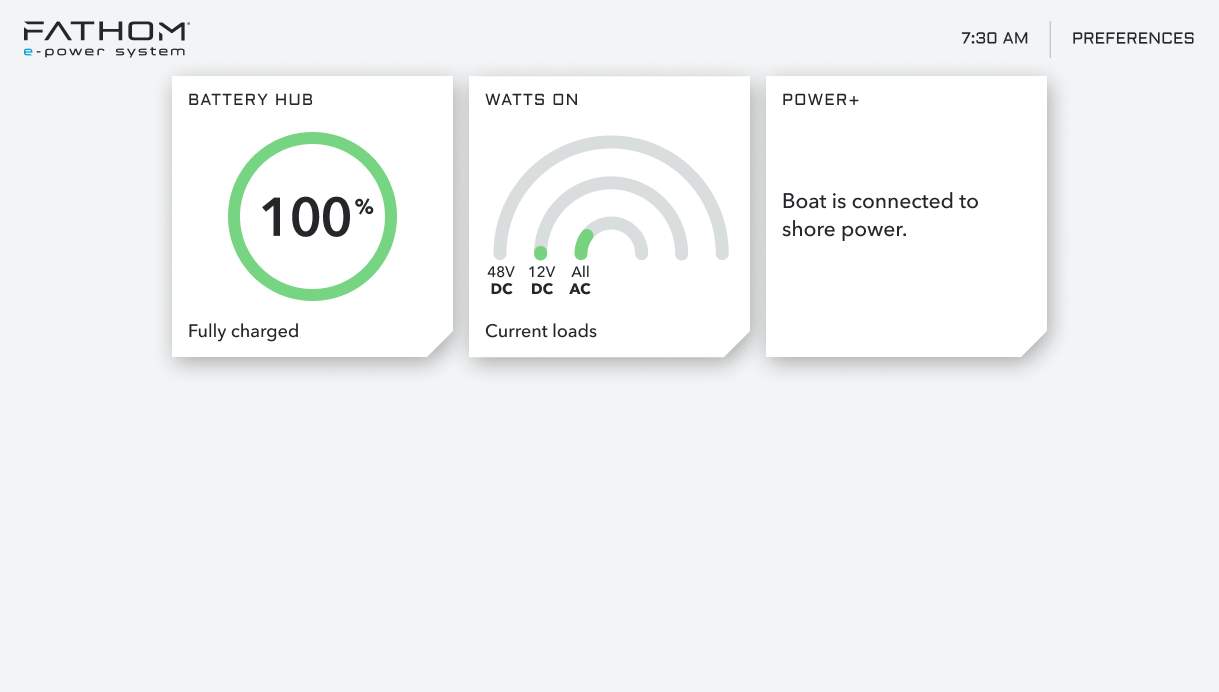
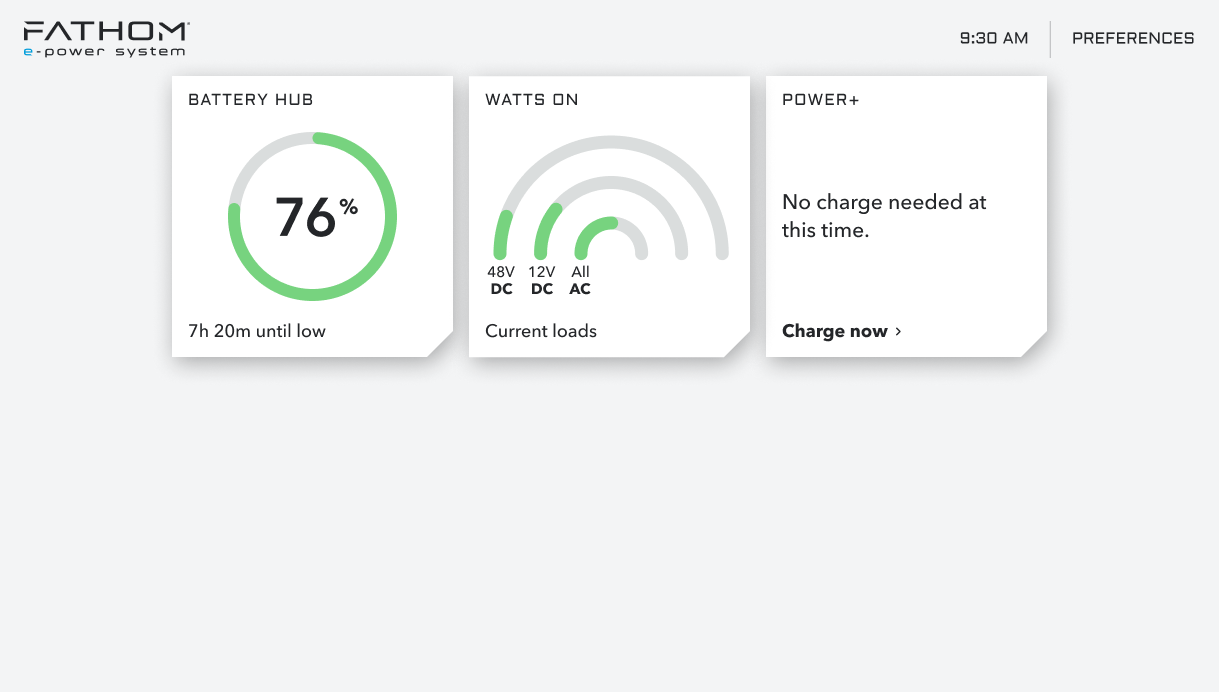

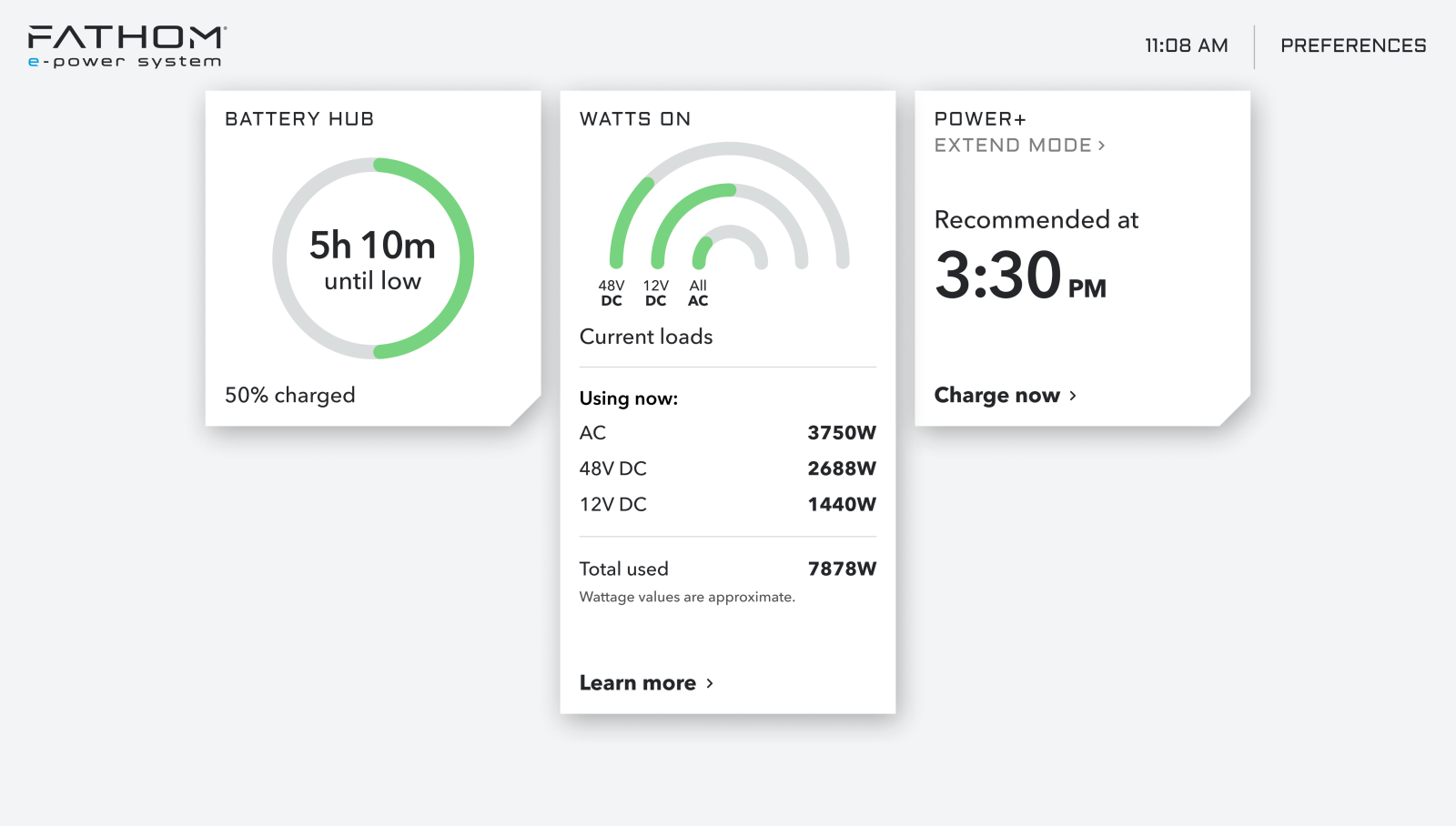


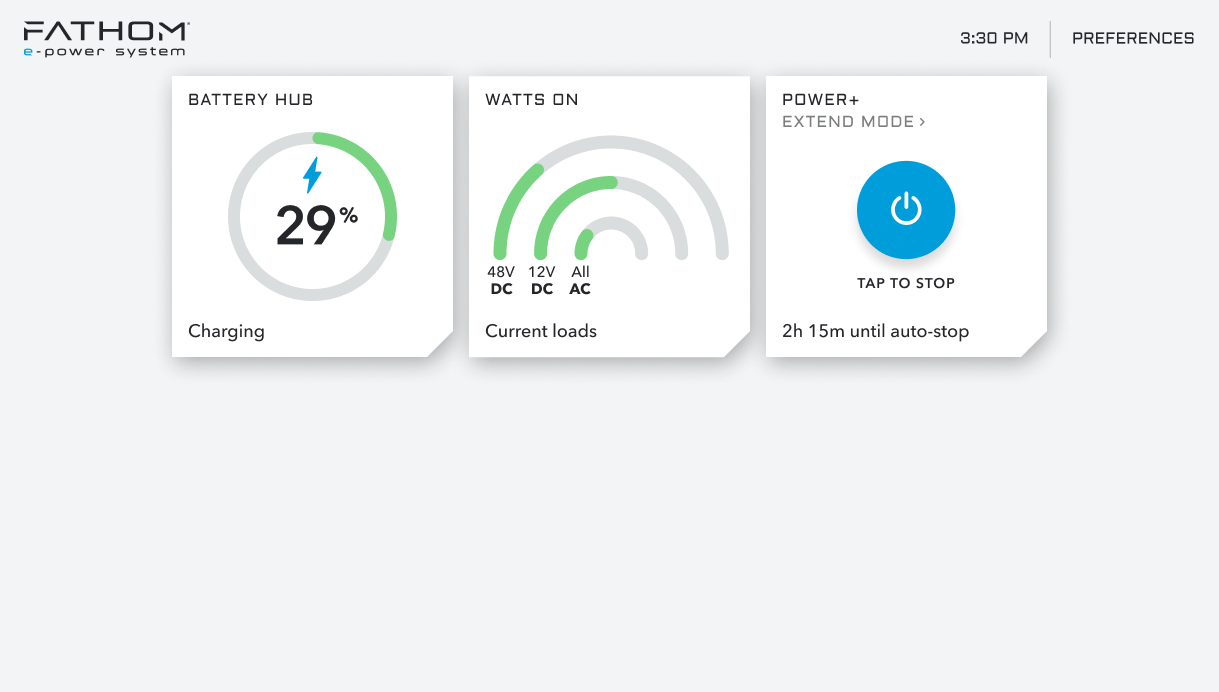
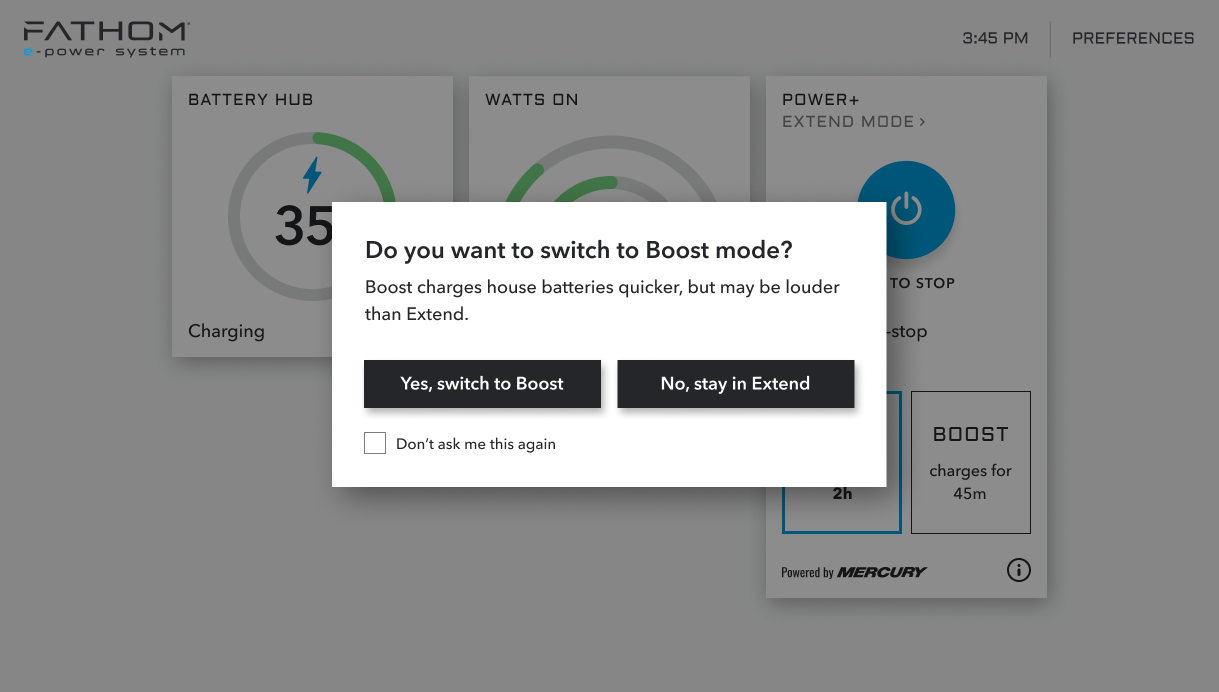
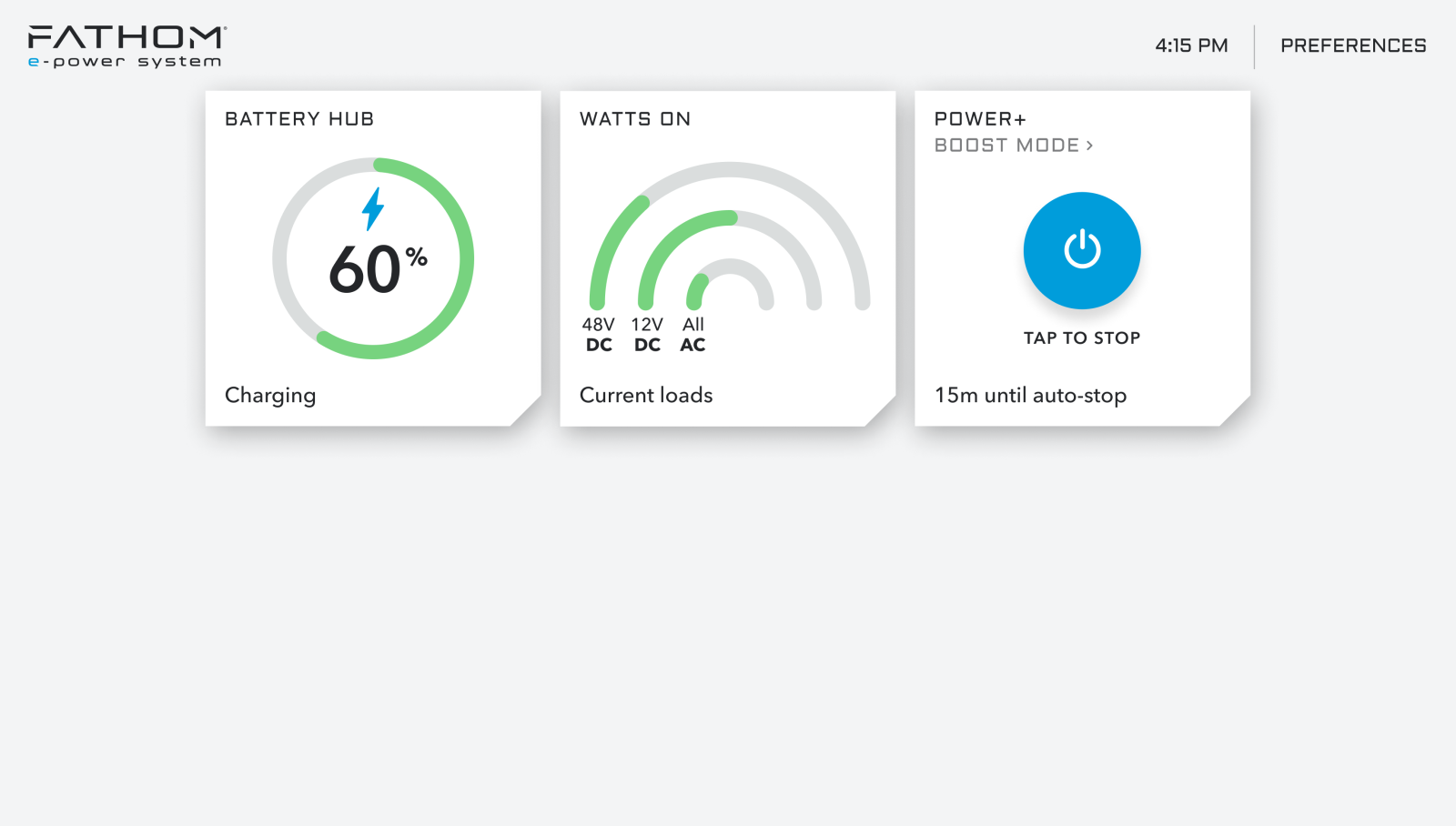
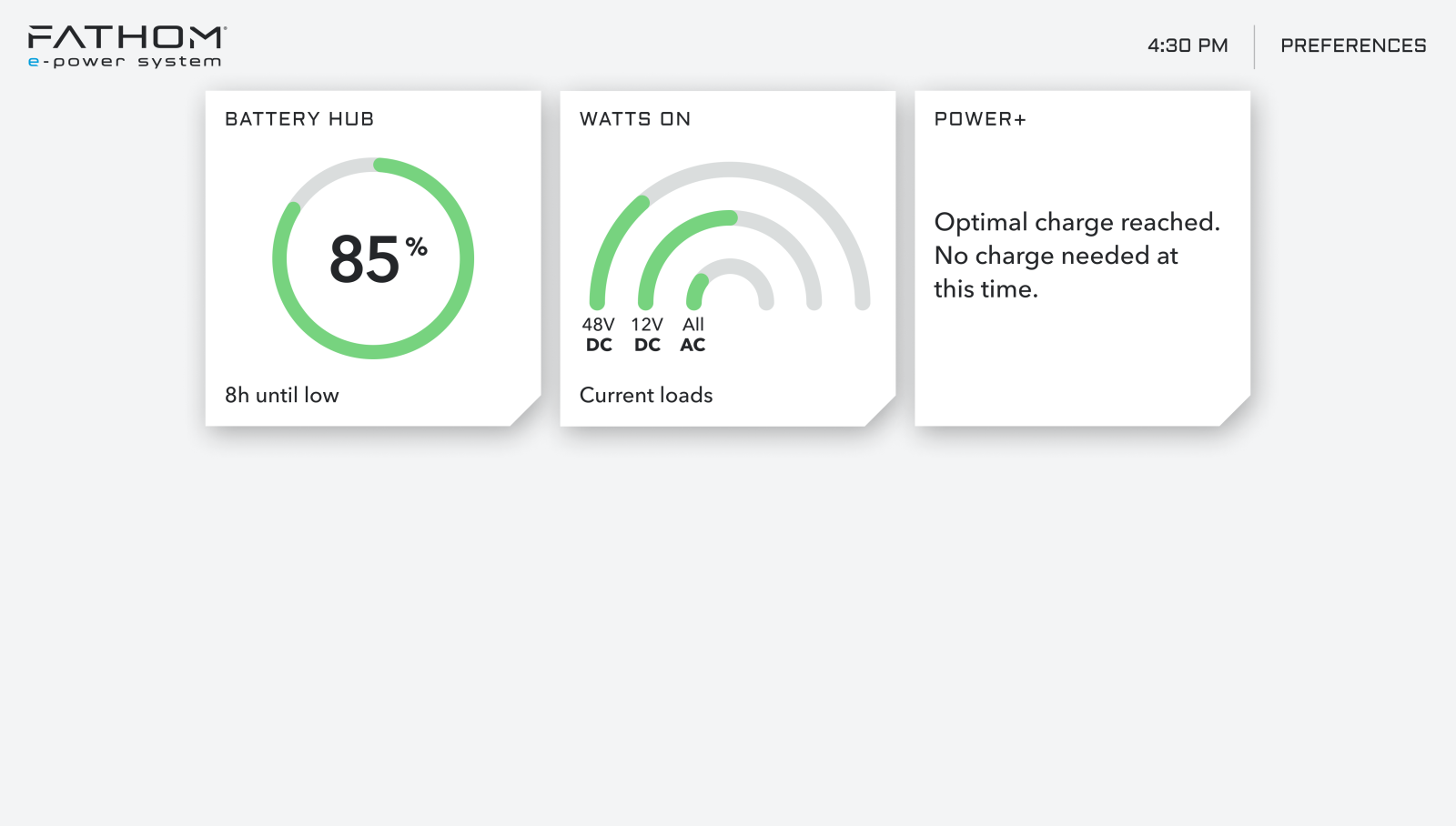
The gallery above shows a day in the life of a Fathom e-Power system through the user interface. The day starts with the boat plugged into shore power and fully charged. At 7:30 am the boat fires up and pulls off the dock. The boat motors to an anchorage, drops the hook and shuts off the engines. There’s enough battery to run the boat’s air conditioning, refrigeration, stereo, and other house loads until mid-afternoon. At that point, the operator is prompted to start the engines, and charging begins. Initially, charging is in extend mode, charging at 3 kilowatts per engine. After charging for a while, the operator changes the charge mode to boost, and charging finishes within 45 minutes. The engines then stop automatically and the batteries return to carrying the electrical loads.
This cycle can repeat as often as needed until the boat returns to shore power (or runs out of gas). A significant advantage to Fathom e-Power is the extended periods of serenity with available power and no engines running. My own cruising experience taught me the value of that quiet time on the boat, enjoying the nature all around us.
Safety systems
Currently, the system won’t automatically start the engine or engines. It will prompt the operator to confirm an engine start is safe. Although the convenience of a hands-off start sounds good, I think the number of ways that could work out badly makes that a prudent strategy. If the system runs long enough to require the engines to restart for more charging, the operator will again have to consent to the start.
The system evaluates the trim sensors of the engines to ensure they are in the water before starting. Additionally, the system uses CO sensors to monitor for safe levels of carbon monoxide. Mercury says the lean burn fuel mapping used in Power+ mode produces dramatically lower CO levels. Thus, they don’t expect problems with the station-wagon effect causing high CO levels. Power+ mode disables shift, steering, and trim controls.
Managing 12-volt vs 48-volt modes
The dual voltage alternator produces either 12-volt power or 48-volt power. The alternator makes 70 amps of 12-volt power at idle and a maximum of 120 amps at cruise. In 48-volt mode, the alternator produces a maximum of 150-amps of 48-volt power, but requires 3,500 engine RPMs to reach peak power. Additionally, in 48-volt mode the alternator has a cut-in of 1,300 RPMs. Thus, at idle, the system remains in 12-volt mode.
Fathom e-Power systems use DC-to-DC converters to allow power to flow from the 12-volt bank to the 48-volt bank and from the 48-volt bank to the 12-volt bank. So, if the alternator is in 48-volt mode, a 48-12 DC-DC converter will continue to supply 12-volt power. Likewise, if the alternator produces 12-volt power, a 12-48-volt DC-DC converter will supply some 48-volt power. However, even at full power in 12-volt mode, the alternator only produces 1.2kw of useable 12-volt power. That means the 48-volt bank is going to get relatively little power.
Impact on the engine
I’ve asked Mercury a lot of questions about using a 10-cylinder, 350 or 400-horsepower engine as a generator. My initial focus was on any impacts to engine longevity. Mercury says they expect Power+, or generator mode, to have a minimal impact on overall engine life because of the low speeds and the alternator’s light load. Additionally, Mercury says that in Power+ mode, as a result of the modified spark and fuel mapping, the engine burns 30-35 percent less fuel than at the same RPM in propulsion mode. Lastly, the modified fuel mapping ensures that despite the minimal load, the risk of carbon build-up is managed.
I also inquired about any potential performance impact as a result of the alternator’s load on the motor. At full production, the alternator consumes 13.5 horsepower. On the 350 horsepower model, that’s just under four percent of the engine’s total power production. Plus, that demand will only be seen when the alternator produces the full 7.2 kilowatts.
I’m not an expert on outboard cooling or design, but I had some worries about the alternator’s ability to keep cool. I assumed that outboard cowlings are designed to draw air through the motor with the boat in motion. The faster the engine turns, the faster the boat moves, and hence the more air flows. So, I asked Mercury what they had to do cool the alternator on a stationary boat. Mercury says the airflow turned out to be adequate with minimal modifications. The alternator has two cooling fans and sits between the air intake and the air box. So, there’s a good flow of fresh air.
Comparing a traditional generator
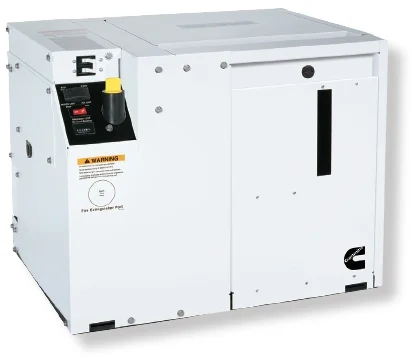
Comparing the e-Power system to a traditional generator is challenging. A boat equipped with a single V10 optioned with the 48-volt alternator produces 7.2 kilowatts of power at cruise and up to 5 kilowatts in Power+ mode at rest. But, most boats large enough to need the capabilities of Fathom are equipped with multiple engines. An informal survey of models from several major center console manufacturers shows generators are available in models starting between 35 and 40 feet. Those models come with two, three or four engines.
| Load | Gallons per hour | KW produced | Gallons per kwh |
| 1/4 | 0.27 | 1.25 | 0.22 |
| 1/2 | 0.34 | 2.5 | 0.14 |
| 3/4 | 0.44 | 3.75 | 0.12 |
| Full | 0.55 | 5 | 0.11 |
Regardless of the generator size, the reality is that most marine generators run lightly loaded. That light loading isn’t very good for the generator, nor its efficiency. Generator size is determined by looking at the maximum potential load on the boat. But, that maximum load is rarely seen. So, the generator loafs along most of its life lightly loaded. The table above shows how much fuel a Cummins Onan 5kw generator burns at several loads. Not surprisingly, the generator is most efficient when fully or nearly fully loaded and loses efficiency as the load goes down. In reality, that generator will run much of its life at loads even lower than 25 percent and hence will likely burn even more than 0.2 gallons per kilowatt hour.
Limiting run time
Possibly the biggest benefit of an e-Power system is the ability to harness the full energy output of the alternator. With a generator, the engine is running any time you need 120-volt (or 240-volt) power available. The e-Power system, by drawing power from a large battery bank, only runs the engine(s) when the batteries are depleted and require charging. Only running the engine(s) when the batteries need charging also means the batteries will accept large charge currents.
Thus far, Fathom e-Power systems have been installed on boats designed for day use. That means, at the end of the day, the boats are likely returning to a dock and shore power. That means the depleted power can be replaced from shore power at utility rates. Even in the most expensive electricity markets, utility rates are nearly always lower than the cost of generating from a diesel or gasoline generator.
If a boat stays away from the dock longer, perhaps a longer day on the water or an overnight, it makes sense to compare the fuel burn of a V10 in Power+ mode to a dedicated generator.
| RPM | Power+ burn | KW output @ 48v | Gallons / KWh |
| 1500 | 1.4 | 2.2 | 0.6364 |
| 2000 | 2 | 5.2 | 0.3846 |
| 2500 | 2.4 | 6.4 | 0.3750 |
I compared how much fuel a V10 would burn to the fuel required for the generator running over 6.4 hours. At quarter load, the generator produces 1.25 kilowatts per hour and it will take 9.6 hours to total 12 KWh produced.
| Configuration | Gallons to generate 12 KWh of power |
| Power+ @ 1500 | 7.6 |
| Power+ @ 2000 | 4.6 |
| Power+ @ 2500 | 4.5 |
| Generator @ 1/4 load | 2.6 |
There’s no doubt, the V10 in Power+ will burn more fuel per KWh than a generator. It will burn between 1.75 and 3 times as much fuel as the generator. But, keep in mind that at cruise, it will generate about 7 kilowatts of power with almost no increase in fuel burn. Plus, for a boat primarily stored with shore power and used for the day, the ability to recharge from the engines is about the ability to extend a day’s fun on the water.
The future of 48-volt
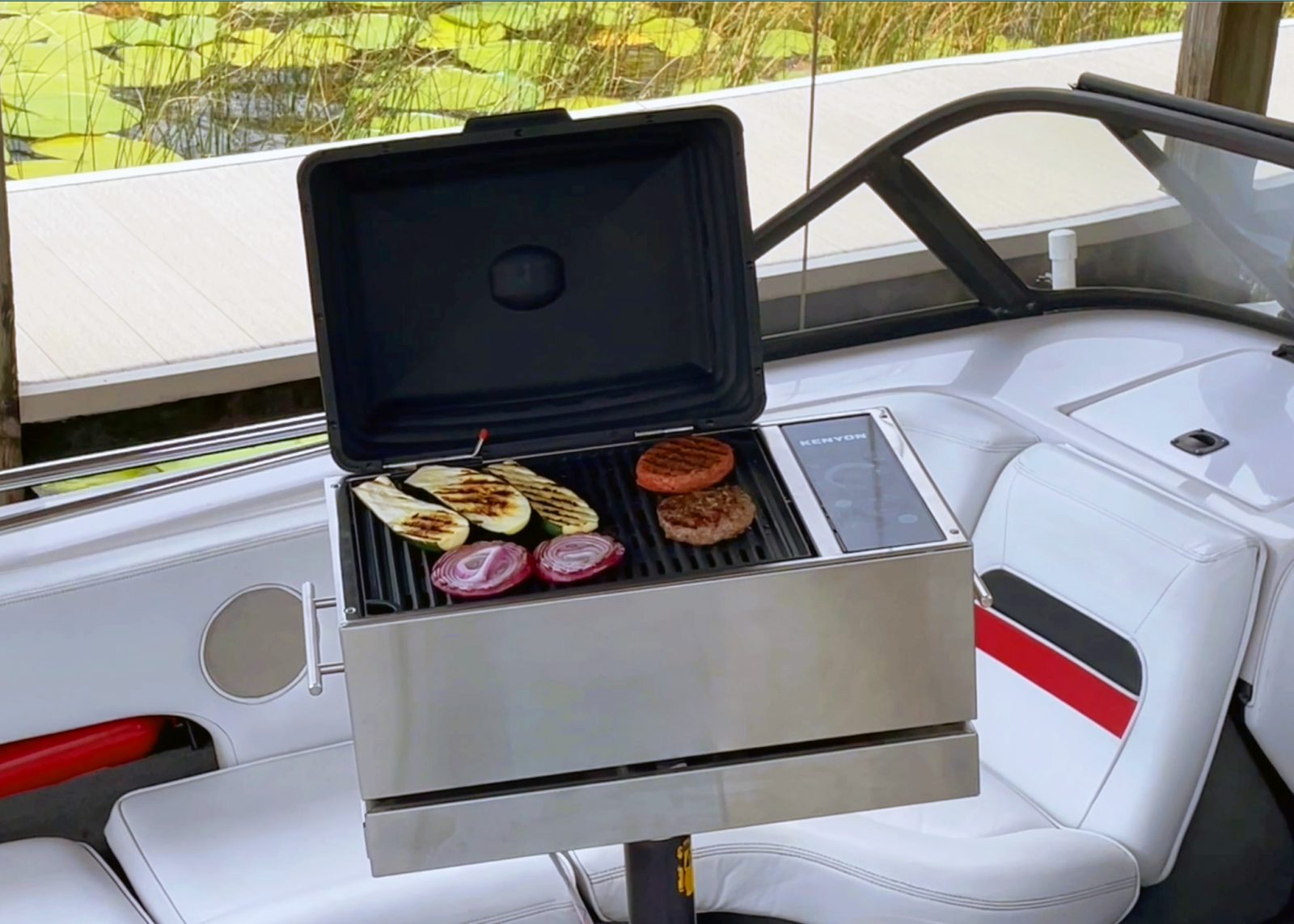
I’ve previously written about 48-volt power on boats and why I think it’s the logical progression for the marine market. As we see larger and larger loads on boats and the desire to get away from generator dependence, 48-volt is a key enabling technology. I’m optimistic that an industry player like Brunswick committing to 48-volt will result in more 48-volt equipment coming to the market. I was quite excited and pleased to help award Kenyon’s 48-volt DC grill an IBEX Innovation award this year. As more 48-volt power systems and 48-volt devices become available,
Final thoughts
The Fathom e-Power system isn’t a fit for every boat out there. As you can see in the math, if you’re going to spend a lot of time at anchor, away from shore power, and not using the main engines for propulsion, a dedicated generator is more efficient. But, if you primarily enjoy your boat during the day, motor a fair amount, and eventually head back to shore power, it’s a great fit. Plus, with one fewer motor to maintain, and potentially avoiding another fuel onboard, it’s a nice reduction in maintenance.
Paired with the 48-volt alternator, the system can recharge a day’s worth of usage in just an hour or two. For me, the ability to get back to enjoying the serenity of an anchorage as quickly as possible is a huge benefit. I do wish the alternator was available to non-Fathom installs but I do understand both the commercial and safety interests served by making it a closed system.


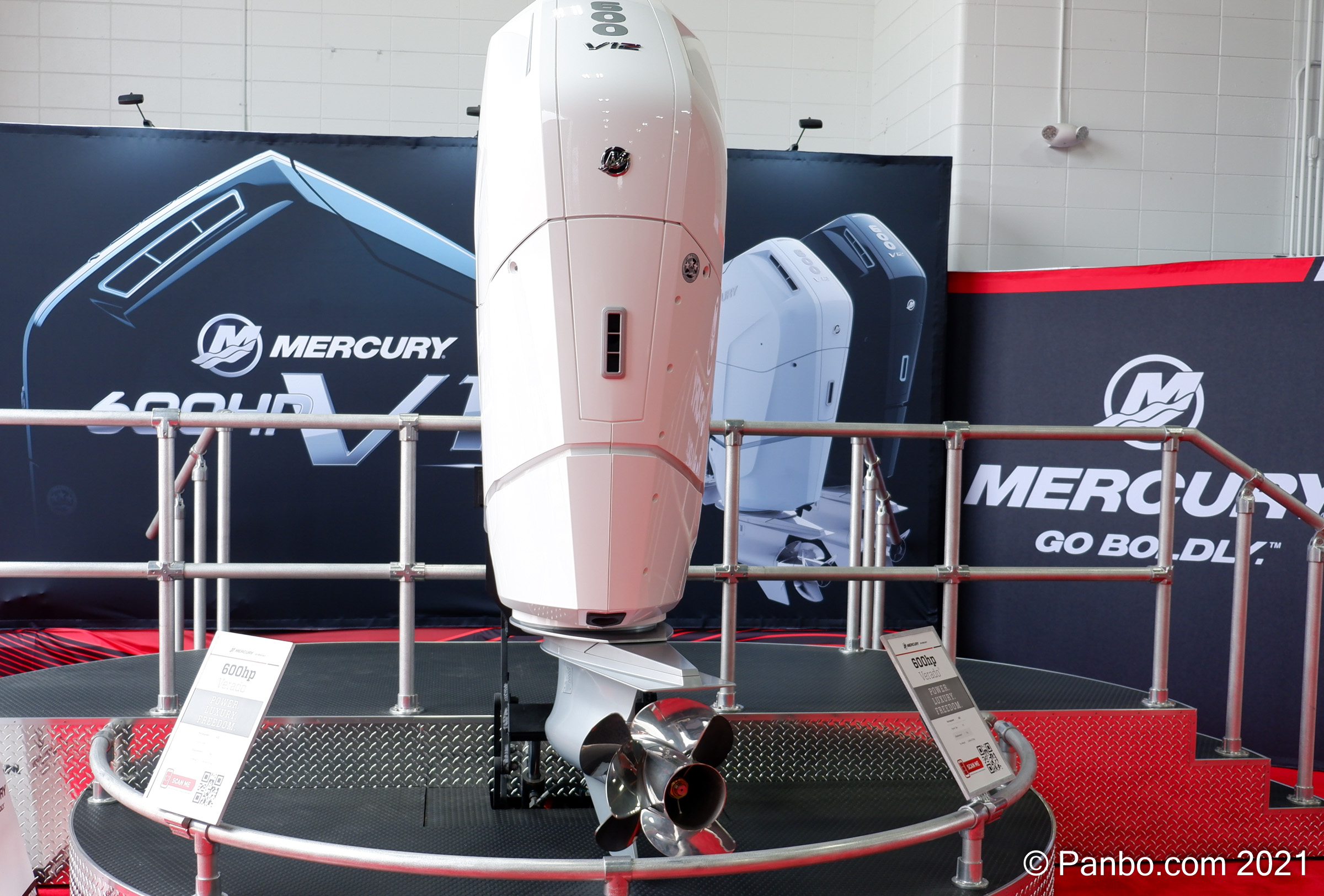











It actually burns a bit more fuel than I thought it would in gen mode. But still given the cost of adding a generator and maintaining it seems like this is a better deal.
I had the same thought. I was guessing it was going to burn less, but then when I looked at the overall numbers the difference in burn seemed less consequential.
It’s pretty cool. With outboard boats it’s been a weird decision of what to do: gas outboards and gas generator (gas generators aren’t as efficient as the Onan in your example). gas outboards and a diesel generator (and maybe diesel heater) with separate gas+diesel, or diesel outboards (unproven) and diesel generator.
This should free up a not-insignificant amount of space, also means no generator thru-hull and discharge hull, and if these are as quiet as Verado V8s, then they are quieter than any generator we’ve run. The space and weight can make up for the tankage, and we would need to buy a lot of fuel to make up for a 10kW generator (twins).
The last puzzle piece for the northwest is heat – particularly going up to Alaska – ideally some sort of DC heat pump that doesn’t involve tons of thru-hulls on a 40′ boat – but I have a feeling it really just means a diesel tank + diesel hydronic heater with 40 degree water temps not favoring the heat pumps.
Too bad they couldn’t fit 2 (or even 3x) of the 48V alternators on those huge engines. The fuel/kWh ratio would be vastly improved in generator mode, for the same reason that AC generators are more efficient when more highly loaded.
They’ve tried to improve the efficiency with lean burn, etc. However even 5kW of output is miniscule relative to the size of the engine. Needs more load to improve the efficiency…
Looks like Mercury has cracked the “code”. Very impressive engineering integration from engine alternator through to charge management controller, engine controller etc. This is modern boating with big LFP house battery banks. Great job mercury engineers on commercializing this advance in tech from the Stone Age 12v systems still marketed by all the other major brands.
Clearly well thought out and executed…leaves all the other outboard (and onboard) engine vendors in the 20th century!
Hey Ben, thanks for the detailed update on Fathom. Clearly a lot of thought and engineering went into this. I still think it only makes sense for for a limited size/style of boat, and a limited mission, which you pointed out in the article.
However, you also stated this:
” With a generator, the engine is running any time you need 120-volt (or 240-volt) power available. The e-Power system, by drawing power from a large battery bank, only runs the engine(s) when the batteries are depleted and require charging. Only running the engine(s) when the batteries need charging also means the batteries will accept large charge currents.”
Most cruisers in the PNW with generators operate in exactly this same way – they have a large house bank (often LiFePO), a large inverter, and can anchor in silence for many hours before needing to run the genset for recharging . I suppose the big variable is heating/cooling – if you need to run AC-powered heat or A/C full time to stay comfortable, then that becomes limiting. But otherwise the fast-idling Fathom outboard ends up being used pretty much exactly like a generator. The biggest advantage I see is eliminating the space/weight/maintenance of the generator, which is not insignificant, and the other efficiencies of 48V vs. 12V. And yes, the automated digital switching and monitoring is impressive.
Anyhow, until it becomes available in a retrofit or re-power scenario, I doubt if we’ll be seeing much of it soon . I just got back from the Seattle Boat show and the least expensive Brunswick day cruiser starts at about a half million bucks. That’s a big investment to experience 48V charging!
Grant,
I think we’re very much on the same page except that our respective climates drive a significant difference. Being in southern Florida, air conditioning is a major factor. I also think Brunswick’s boats with the Fathom system onboard are targeting a warm weather climate where A/C dependency is the norm.
As for the cost of the system, to my eye that’s not the only trouble, the current crop of boats with the system installed aren’t a style of boats I find compelling. In fact, as I was writing this I found myself thinking about the potential for something like a Ranger Tug fit with the system. Pair that Ranger Tug with Bruce’s suggestion of multiple alternators on a single motor and you could be talking about cruising energy management perfection!
-Ben S.
I haven’t seen it mentioned but the basic concept is similar to the Integral system that was talked about a lot 3-4 years ago. Using the main engine as a power source when it had extra power available thru a 48V alternator. I seem to recall early installations of those had issues, but it would seem there will likely be more of these systems in the future.
Last year I was playing with building a small cruising tug for myself, and I started to draw up a shaft driven alternator with a belt system to the prop shaft allowing forward and reverse without a transmission (similar to how Rob white coupled a Kubota to the prop shaft on his Resuce Minor). At some point I wondered if it might make more sense on a small displacement cruising boat to just make a 48V generator and use an electric drive. This wouldn’t be about propulsion efficiency but instead about using unused HP for house loads. It also allows for layout flexibility.
Anybody have a Part Number for the new 150amp 12v alternator?